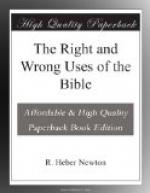As the crown and consummation of religion, the holy hope of life beyond the grave dawned in this night of suffering, gleaming toward the day of Him who brought life and immortality to light.[52]
Around this deepening and enriching life the remarkable body of the prophetic-priestly system was fashioned, as the law of the new nation when it should gain once more the old home. It looked to the formation of a holy people; through its minute direction of the daily life, its sacrificial symbolism charged with spiritual significances, its sacred books for the instruction of the people, its order of scribes devoted to this new study, its synagogues or meeting-houses for oral teaching and for prayer—now for the first time elevated into an act of public worship co-ordinate in dignity with sacrifice.
True to its old instinct, Israel’s religion, first seeking to build up individual holiness, turned then to build up social righteousness. The ideals of the great prophets, which had been long working in the minds and hearts of the leaders of the people, were now embodied in the priestly legislation. The traditional communal system of land-holding was established as the legal basis for the new nation. The land of Israel was nationalized, and its title vested in God, from whom individuals received the right of limited usufruct. It could not be sold outright. No man could gain a fee-simple proprietorship. The seventh year was continued as a year of fallow when the poor were to have the right of pasturage and of such growth as the land spontaneously brought forth. At the end of seven sabbatical periods, in round numbers every fifty years, all purchases of land were to lapse, and the soil return to the original possessors. At the same time all debtors were to pass through a general act of bankruptcy and go forth free men. Interest was not to be allowed on loans made between brother Israelites. By these provisions both villeinage or land-serfdom and the slavery of debtor classes to capital were to be prevented in the new nation. This legislation of the restoration was “to the end that there be no poor among you."[53]
To such impracticable ideals, for that age, did this exilic movement of the new religion look, with sober, strenuous, systematic effort for their realization; and therein may we see its intensity of moral life.
VI.
The period of the Restoration, from B.C. 536.
The common notion is that this period of Israel’s history was practically a vacuum, and that through five centuries the nation experienced no further development. In reality, it was an exceedingly active period, characterized by most important developments. Politically it was a period of constantly changing influences. Israel was scarcely ever really independent during these centuries. Her changes were the changes from one master to another. But this very subjection




